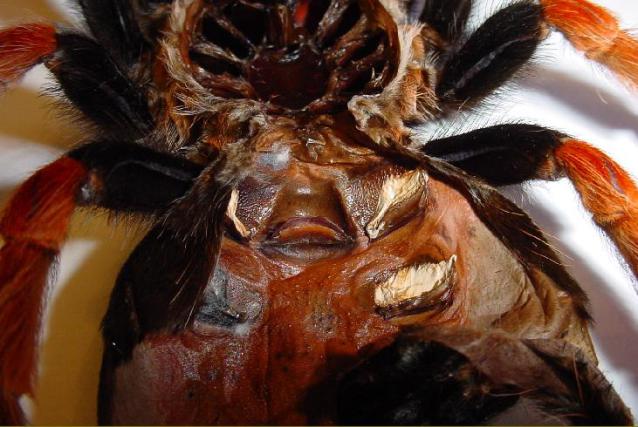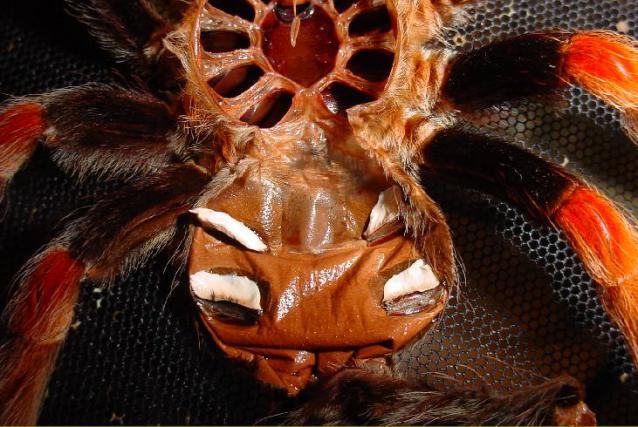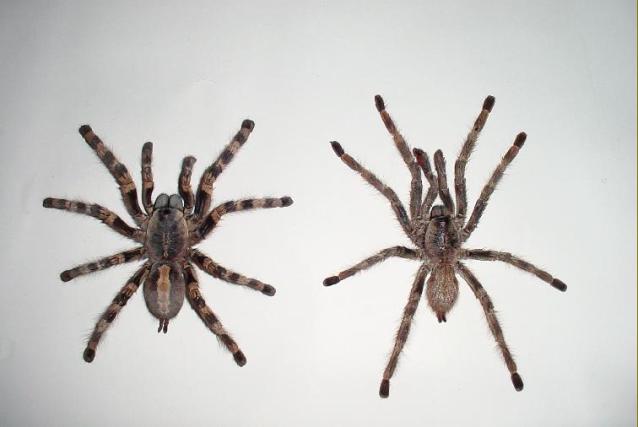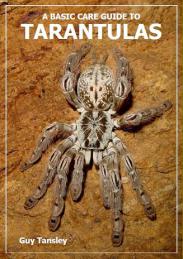
SEX DETERMINATION
Successful sex determination of a tarantula from their cast skin is possible from as early as the fourth moult with the aid of a stereoscopic microscope. Concentrating on the female tarantula, and those well past their sixth moult, the process is relatively simple - requiring little more than a fresh cast skin, a pair of forceps and possibly a small hand lens. Determining the sex of a tarantula is important in many ways if you plan to breed from your stock. Feeding rates can be increased or reduced to coincide with the arrival of males, specimens can be sold as a guaranteed sex so fulfilling the customers requirements and immature males can be purchased at a lower price as a future investment (not that anyone breeds tarantulas for the money, of course!).
Sub adult male B. boehmei cast skin.
These photographs show
the well defined sex organs of both male and female tarantula Brachypelma
boehmei. From an early stage in the spiders development,
the signs of a female are quite obvious and although the actual spermatheca (sex organs which receive and store the sperm) aren't fully formed, successful determination is possible with the
appearance of a heavily folded area known as the uterus externus (the large, upward and curved piece of semi-transparent 'skin') and a large lower lip. This lip is present before any real signs of
the spermatheca proper and there is a marked difference in the immature male. Inspection of a suspected male cast skin is again obvious if the specimen is fairly large as none of the above features
are present.
If determination is required earlier in the spiders development, then things become slightly more complicated and I recommend either sending your spider to registered sexing practitioner (details can
be found in the Journal of the British Tarantula Society) or reading further on the subject. "Sex determination of immature theraphosids from their cast skins" by Kathleen and John Hancock for example.
Matching these photographs to the line drawings in the above mentioned book will give a better idea of what the females spermathecae and epigynum area actually look like in relation to the other
features (book lungs etc., seen here as the large white areas on either side of the central epigynum). Now all you have to do is wait for your young tarantula to moult!
Another sexing technique is to inspect the underside of the tarantulas abdomen as there are slight differences between males and females. The important area on the underside of the abdomen is called
the epigastric furrow and this is located between the first pair of book lungs nearest the pedicel or waist (see photographs below).
Adult female epigastric furrow (left) and sub-adult male epigastric furrow (right).
Adult and sub-adult tarantula males have
structures called epiandrous glands located between the first pair of book lungs and are surrounded by a dense patch of hair that can sometimes be seen with the naked eye. This area between the book
lungs is also much narrower in males and is lacking the deep fold found in females. In some species it can be difficult to see this area so although not as accurate as using cast skins, this method
can prove useful when a recent moult is not available and (with a little practice) positive sex can be determined.
Once adult, sex determination becomes simple as males go through some important physical changes when they go through their final
moult. For a more information on the mature male, click here.



